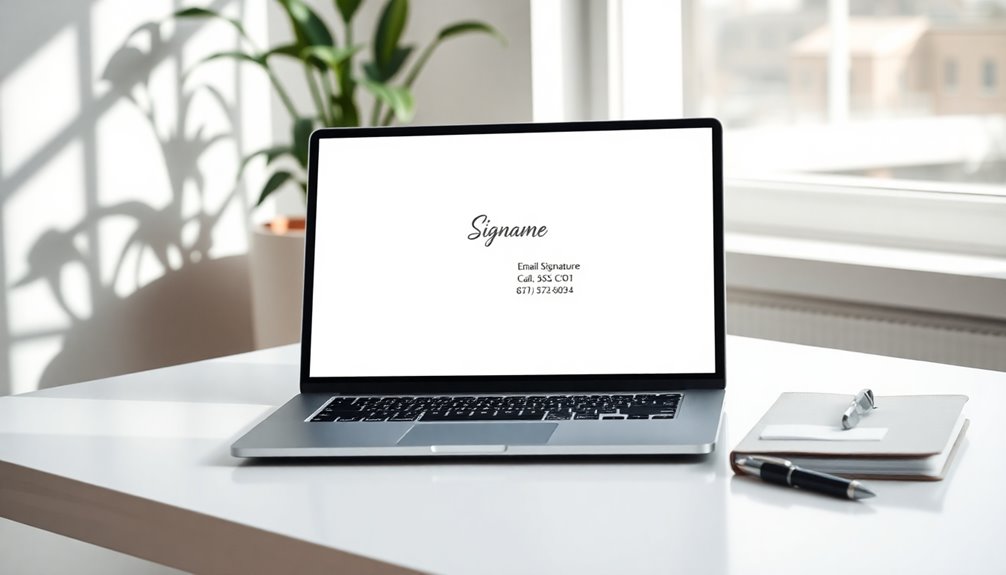To write a sick day email that keeps you covered, start with a clear subject line like "Sick Day: [Your Name]." Briefly explain your illness without going into too much detail. Specify how long you expect to be absent and offer to help with urgent tasks if possible. Always send your email as early as you can to prevent workflow disruptions. Keep your tone professional and respectful, expressing gratitude for the team's understanding. A well-crafted email not only informs but reassures your employer. Stay tuned to discover more tips that will make your communication even more effective!
Key Takeaways
- Use a clear subject line like "Sick Day: [Your Name]" to indicate the email's purpose immediately.
- Briefly explain your illness without going into excessive detail to maintain privacy.
- Specify the expected duration of your absence to help with workload planning.
- Offer assistance with urgent tasks remotely if possible, showing commitment to your responsibilities.
- Follow up with a confirmation of your return date to minimize uncertainty for your employer.
Introduction

When you're feeling under the weather, notifying your employer about your absence is essential. A sick day email serves as a formal notification of your unavailability due to illness, allowing for effective communication and maintaining workplace productivity.
Ideally, you should send this email promptly upon realizing you can't work, preferably before your workday begins. This timing helps your employer reallocate tasks and manage workload coverage efficiently.
In crafting your sick day email, it's crucial to include a clear subject line that reflects your absence. Be concise in your explanation of your illness, and mention the expected duration of your absence.
If possible, outline any arrangements you've made for covering your responsibilities, whether that's delegating tasks or working remotely if you're able.
Maintaining a professional tone throughout your email fosters trust and ensures a supportive work environment. Familiarizing yourself with your company's sick leave policies can guide you in structuring your email appropriately, aligning with organizational expectations.
Maintains Professional Communication Standards

Maintaining professional communication standards is vital for fostering a respectful workplace, especially during times of absence. When you send Sick Day Emails, you set the tone for how your situation is perceived.
Start with a polite greeting to establish a respectful connection right from the beginning.
Ensure you have a clear subject line that indicates your absence due to illness, like "Sick Day: [Your Name]." This helps your manager recognize the email's importance immediately.
It's essential to communicate your situation promptly, ideally before the workday starts, allowing for timely adjustments within the team.
In your email, briefly explain your illness without delving into personal details, upholding respect for privacy. If you know the expected duration of your absence, include that information to assist management in planning for coverage and task delegation.
Throughout your email, maintain professionalism with a clear structure and a courteous tone. This approach not only reflects your commitment to your role but also builds trust and respect between you and your management team, making it easier for others to support your absence.
Clear and Concise Subject Line

A clear and concise subject line is crucial for effective communication, especially in a professional setting. When you send a sick email, your subject line should immediately indicate your purpose. For example, using "Sick Day: [Your Name]" ensures that your message grabs attention right away. Including your name helps recipients quickly identify who's absent, which is especially helpful in larger organizations.
Aim to keep your subject line under 50 characters for optimal visibility in email previews. Phrases like "Out Sick Today" or "Unavailable Due to Illness" deliver clarity about your absence without overwhelming details. This straightforward approach not only communicates your situation but also shows your respect for your recipient's time.
A well-structured subject line sets a professional tone for your email, reinforcing the importance of clear communication. By crafting a concise subject line, you help your employer understand your situation promptly, allowing them to make necessary adjustments at work.
Step-by-Step Sick Email Instructions

Crafting a sick day email doesn't have to be complicated. Start with a clear subject line, like "Sick Day: [Your Name]," so your supervisor immediately knows the email's purpose.
As soon as you realize you can't work, notify your supervisor and any relevant team members, ideally before your scheduled start time.
In your message, include a brief explanation of your illness without sharing too many personal details. If you know the expected duration of your absence, mention that too. For example, you could say, "I'm feeling unwell and expect to be out for the next two days."
If you're able, offer to assist with any urgent tasks remotely and suggest colleagues who can cover your responsibilities during your absence. This shows your commitment to the team's success, even while you're away.
Dos and Don'ts for Sick Emails

When it comes to sending a sick day email, knowing what to include can make a big difference. First, inform your manager as soon as you realize you're unable to work. Ideally, send your email before your shift starts to help your team make necessary adjustments.
Keep it simple and provide a brief explanation of your illness, but don't share excessive personal details. It's important to maintain professionalism while addressing your health and well-being. If you know your expected return date, mention it; this helps your colleagues plan accordingly and reduces uncertainty about your absence.
Don't wait until the last minute to write a sick day email, as this can disrupt team workflow. Additionally, don't forget to include a colleague's name who can handle urgent matters in your absence. This ensures continuity and shows your commitment to your role, even when you're on sick leave.
Examples of Sick Leave Emails

If you're working from home, you could write, "I am feeling unwell but will be available to respond to emails and complete urgent tasks from home."
Lastly, for a mental health day, you might say, "I am taking a sick day today to focus on my mental health and will be back in the office tomorrow."
Each of these examples maintains a professional tone while clearly communicating your situation.
Pro Tips for Writing Effective Emails

Writing a sick day email can feel daunting, but following some pro tips can make the process smoother. Start with a clear subject line like "Sick Day: [Your Name]" to ensure immediate recognition. A polite greeting sets a professional tone, so keep it simple.
Briefly explain your absence without oversharing personal details, and if you know how long you'll be away, include that information to help with workload management.
Be sure to address any critical tasks or deadlines that might be impacted by your absence. Suggest how your responsibilities can be delegated or managed to ease the burden on your colleagues. This shows that you're considerate of their time and efforts.
Close your email with a note of gratitude for their understanding, as it fosters goodwill during your absence. Finally, provide your contact information for urgent matters, which maintains professionalism and assures your team that you're still available for pressing issues.
Using an email template can streamline this process, allowing you to communicate effectively while keeping the necessary formalities in check.
Final Thoughts

Crafting a sick day email is a vital skill that can simplify the communication process between you and your employer. A well-structured email not only ensures effective communication but also sets the stage for smooth workload management within your team.
Start with a clear subject line that immediately informs your employer of your situation.
In your email, provide a brief but clear explanation of your absence. This demonstrates professionalism and helps avoid any misunderstandings. If possible, include your expected return date; this small detail shows consideration for your colleagues and their planning needs.
Maintaining a professional tone while being honest about your health fosters trust and respect between you and your employer.
It's also crucial to familiarize yourself with your company policies regarding sick leave. This knowledge can help you adhere to specific guidelines and prevent complications related to your absence.
Frequently Asked Questions
How Do You Write a Professional Sick Day Email?
When you write a professional sick day email, start with a clear subject line like "Sick Leave Notification: [Your Name]."
Use a polite greeting and briefly mention your illness without too much detail.
State your expected return date, and if possible, share your availability for urgent matters.
Also, include a colleague's name who can cover your responsibilities.
Make sure to send the email promptly, ideally before the workday begins, to help your team adjust.
How Do You Politely Email Sick Leave?
To politely email sick leave, start with a clear subject line indicating your absence.
Greet your manager warmly, then briefly explain that you're unwell and can't work.
Specify how long you expect to be away, ideally including a return date.
Mention any important tasks and who can cover them.
Thank your manager for their understanding, and offer a way to reach you for urgent matters, if necessary.
How Do You Say "I'm Sick Professionally"?
When you need to say "I'm sick" professionally, keep it concise and respectful.
Start with a clear subject line and a polite greeting. Briefly explain your illness without oversharing, stating that you can't work due to health reasons.
If possible, mention how long you expect to be away. Wrap up by thanking your employer for their understanding.
This approach maintains professionalism while clearly communicating your situation.
How Do You Write a Sick Day off an Email?
When you write a sick day email, start with a clear subject line, like "Sick Day: [Your Name]."
In the body, briefly explain your situation without going into too much detail. Let your manager know how long you expect to be out, if possible.
Highlight any important tasks that might need attention and provide instructions or a colleague's contact info.
Make sure to send it as soon as you realize you can't work.









